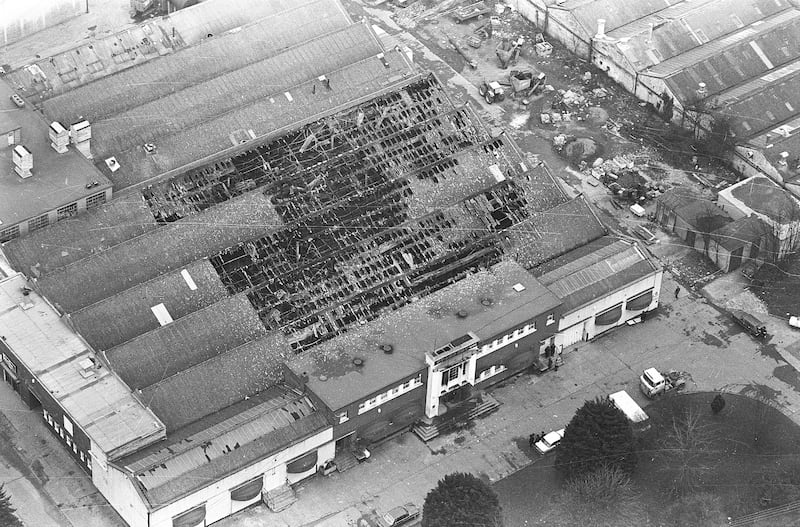Graphic descriptions of “charred” and “unrecognisable” remains of young people, some found holding hands or within “steps” of exits, killed in the 1981 Stardust inferno were heard at Dublin coroner’s court on Tuesday.
Now in the third module of evidence, fresh inquests into the deaths of 48 people, aged 16-27 in a fire at the north Dublin nightclub in the early hours of February 14th, 1981 are hearing from firemen who were first on the scene. The first modules heard from staff and management, and from patrons on the night of the fire.
James Tormey, a 30-year-old fireman with Dublin Fire Brigade (DFB) based in Tara Street station at the time, found five bodies in the aftermath of the blaze. Two “sets of casualties” he particularly remembered.
“One was at exit three. It was a torso which was... the upper part of the body with parts of a red jumper sticking out... and a gent’s watch. So, I assumed it was a gentleman and my feeling was that that poor individual was two or three steps from safety.
RM Block
“Earlier on, around the stage area there appeared to be two bodies on the stairs... on the steps between the seats. It seemed like two young people sitting on the stairway, arms around each other and the bodies were fused as one.” He did not know whether they were male or female.
“I thought at the time, what those poor people were thinking at the time as they were trying to comfort each other before they met their demise,” said Mr Tormey.
He had earlier described rescuing “five or six” young people from a dressingroom behind the stage.
William Redmond, a 42-year-old fireman based in Tara Street at the time, found nine bodies once the fire was extinguished.
In his 1981 testimony, read into the court record as he was not available to appear, Mr Redmond described a “big crowd” of young people – some injured, shouldering and carrying other young people, their faces blackened and clothes smouldering – “roaming all over the place” as the fire-tender on which he arrived came on the scene, before 2am.
Wearing breathing apparatus he entered the building at exit one – up a metal staircase at the side. He went down the passageway arriving at the back of tiered seating, from where he “could see the whole area” inside the building. “It was an inferno inside. The ceiling tiles were falling down in big sheets... The asbestos roof itself was exploding all over the place... The building itself was lit up from the fire.”
Three-quarters of an hour after his arrival the fire was under control and it was “pitch black” inside. He got a hand lamp and went back into the building to search for bodies.
“On the sloped seating opposite the main doors... about two seats down... I found one charred body on the floor under a table,” he said. “I found another body about four seats in from exit six... I found two charred dead bodies together. They were lying on the floor, one sprawled across the other,” he said.
“About five feet away from the front of the stage on the dance floor I found two more bodies together. They were lying beside each other and they looked like they were holding hands. On top of the stage... I found three charred bodies. Two were lying flat on the stage facing upwards and a third was lying across them facing down.”
He marked the location of each body by placing a grey blanket over them. “I just left them there awaiting further orders,” said Mr Redmond. “Some bodies were placed on stretchers and others were placed on carrying sheets... They were removed through exits four and five... [and] lined up on the ground outside.”

Brian Parkes, 36 years old at the time, was acting station officer at Tara Street working out of North Strand station on the night. He and his crew arrived at the scene at 1.52am, just after another tender from Kilbarrack station. En route, from the Malahide Road “you could see the flames” from the Stardust “and we knew the roof was gone”, he told the court.
On arrival, he entered through exit three leading to the backstage area, and into a dressingroom. “There was a pile of bodies. The top three or four I should hope were alive. I called immediately to the lads, the lads came pouring in and we grabbed them and brought them out... That was the last of the people alive, I think, taken out of the Stardust.”
He and colleagues assembled outside exit five where a third officer in charge organised the step-by-step search for bodies. “There was civilians helping us... There was obviously relatives looking for their relatives as well,” said Mr Parkes. “We said, ‘We don’t want them to see what’s inside’.”
Gardaí moved civilians to an area away from the exits through which bodies would be brought. This allowed the Dublin Fire Brigade to “systematically remove” the remaining bodies, many of whom “had to be untangled” from wires and debris that had fallen on them when the roof collapsed.
“Lads came in with stretchers. We just had the stretchers in the aisles. We used carrying sheets in between because you couldn’t get the stretchers in. They’d get tangled in the wires. We removed the wire and took the bodies out and then on to the stretchers and took them outside.”
The young people’s remains were “lined up” on the ground between exits four and five, where up to 35 bodies lay, the inquests heard.
The inquests continue.
- Find The Irish Times on WhatsApp and stay up to date
















